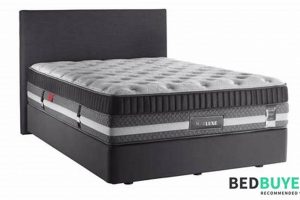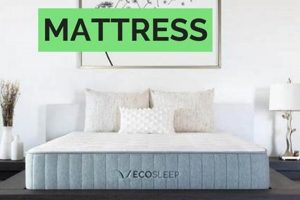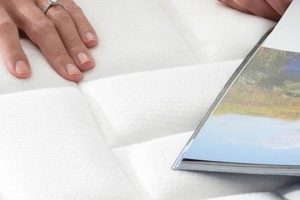A sleep surface incorporating individually wrapped coils that respond independently to pressure, providing targeted support and minimizing motion transfer, often represents a superior choice for restful sleep. This construction method allows for conformance to the body’s contours, distributing weight evenly and alleviating pressure points. For instance, a model featuring higher coil counts and zoned support may be particularly beneficial for individuals with back pain or those sharing a bed.
The significance of this design lies in its ability to promote spinal alignment and reduce sleep disturbances. Unlike traditional innerspring mattresses where interconnected coils transfer movement across the entire surface, the isolated nature of the coils prevents one sleeper’s movements from affecting the other. Historically, advancements in spring technology and manufacturing processes have led to the development of increasingly sophisticated support systems, enhancing both comfort and durability.
The following sections will explore the key factors to consider when selecting a sleep surface of this type, including coil gauge, layer composition, edge support, and material certifications, providing a framework for informed decision-making.
Selecting a Superior Innerspring Sleep System
The subsequent guidelines assist in the evaluation of an individually pocketed coil mattress, enabling an informed purchasing decision that aligns with individual comfort preferences and support requirements.
Tip 1: Coil Gauge Assessment: Examine the coil gauge, as lower numbers denote thicker coils offering greater firmness and durability. Individuals preferring a more supportive feel should consider models with a lower gauge, typically between 12 and 14.
Tip 2: Coil Count Evaluation: A higher coil count, particularly in queen and king sizes, generally indicates more precise support and improved contouring. Look for mattresses with at least 800 coils for a queen and 1000 for a king size to ensure adequate support and minimize motion transfer.
Tip 3: Zoned Support Consideration: Mattresses featuring zoned support, with varying coil firmness in different areas, can provide targeted support to the lumbar region and shoulders. This design caters to the body’s natural curvature and may alleviate pressure points.
Tip 4: Layer Composition Analysis: Scrutinize the materials used in the comfort layers above the coil system. Memory foam, latex, or high-density polyfoam can enhance comfort and pressure relief. Evaluate the density and thickness of these layers to ensure adequate support and longevity.
Tip 5: Edge Support Inspection: Robust edge support prevents sagging and maximizes the usable sleep surface. Look for reinforced edges, often constructed with high-density foam or additional coils, to maintain structural integrity and facilitate getting in and out of bed.
Tip 6: Material Certification Verification: Confirm that the materials used in the mattress meet established safety standards. Certifications such as CertiPUR-US for foams or OEKO-TEX Standard 100 for textiles ensure that the mattress is free from harmful chemicals and substances.
Tip 7: Trial Period and Warranty Review: Prioritize mattresses offered with a risk-free trial period, allowing sufficient time to assess comfort and support. A comprehensive warranty protects against manufacturing defects and premature sagging, providing long-term peace of mind.
By carefully considering these factors, prospective buyers can identify an innerspring sleep system that effectively meets their individual needs and preferences, promoting improved sleep quality and overall well-being.
The subsequent discussion will address the maintenance and care of pocket spring mattresses to prolong their lifespan and ensure continued optimal performance.
1. Coil Count
Coil count within a pocket spring mattress represents a critical factor influencing its overall performance and suitability for individual needs. It directly affects the mattress’s ability to provide targeted support and minimize motion transfer, thereby contributing significantly to sleep quality.
- Support Distribution
A higher coil count generally translates to more individual coils working independently to support the body. This increased density allows for finer-tuned contouring and weight distribution, reducing pressure points and promoting spinal alignment. For example, a mattress with 800 coils will typically conform to the body’s shape more precisely than one with only 400 coils, resulting in enhanced comfort and reduced discomfort, particularly for individuals with back pain.
- Motion Isolation
The independent nature of pocket springs is enhanced by a higher coil count. Each coil reacts individually to pressure, preventing motion from spreading across the mattress surface. This is particularly beneficial for couples, as it minimizes disturbances caused by one partner’s movements during the night. A higher coil count effectively isolates movement, contributing to undisturbed sleep for both individuals. For Instance a person tosses on the other side and you didn’t feel it
- Durability and Sag Prevention
A greater number of coils can contribute to the overall durability and longevity of the mattress. With increased support points, the mattress is less likely to sag or develop impressions over time. This is because the weight is distributed more evenly across a larger number of coils, reducing stress on individual components. A mattress with a lower coil count may be more prone to sagging, particularly in areas where weight is concentrated.
- Cost and Material Considerations
While a higher coil count generally indicates a superior mattress, it is important to consider the quality of materials used in conjunction with the coil count. The type of steel, the thickness of the coils (gauge), and the construction of the surrounding comfort layers all play a role in determining the overall value and performance of the mattress. A mattress with a lower coil count but high-quality materials may outperform one with a higher coil count but inferior materials. Cost also generally goes up, with more number of coils. The price directly correlate with the coils.
The coil count is undeniably a defining feature that contributes to the attributes associated with the terms “best pocket spring mattress”. The number of coils is a large factor that plays a role in the best mattress, without a higher number of coils the support and quality will not stand out. When selecting a pocket spring mattress, coil count should be evaluated in conjunction with other factors such as coil gauge, material quality, and comfort preferences to ensure a satisfying and supportive sleep experience.
2. Coil Gauge
Coil gauge, expressed as a numerical value, significantly influences the firmness and support characteristics of a pocket spring mattress. This measurement denotes the thickness of the wire used to construct the individual coils. A lower gauge number indicates a thicker, more robust coil, resulting in a firmer and more supportive feel. Conversely, a higher gauge number signifies a thinner coil, yielding a softer, more yielding surface. The selection of an appropriate coil gauge is critical in achieving the desired comfort level and ensuring adequate spinal support, factors essential in defining a superior pocket spring mattress.
The correlation between coil gauge and perceived firmness directly impacts the suitability of a mattress for different sleep preferences and body types. Individuals who prefer a firmer sleeping surface, often those with back pain or who sleep on their stomach, generally benefit from mattresses with lower gauge coils. The increased resistance provided by thicker coils offers enhanced support and helps maintain spinal alignment. Conversely, side sleepers or those who prefer a softer, more contouring feel may find higher gauge coils more comfortable, as they allow for greater compression and pressure relief. An innerspring system’s ability to cater to various preferences and body types is a key measure for those searching for the best sleep surface.
Ultimately, the coil gauge contributes to the overall performance and longevity of the sleep system. Thicker coils, while providing greater firmness, also tend to be more durable and resistant to sagging over time. Therefore, the optimal gauge represents a balance between desired comfort and long-term support. The consideration of coil gauge, alongside other factors such as coil count and zoning, leads to the selection of an individually wrapped coil support system that effectively caters to individual needs. When referring to the best sleep surface, coil gauge should be seriously considered, without it the benefits and support level cannot be obtain.
3. Zoned Support
Zoned support, in the context of a pocket spring mattress, refers to the strategic variation of coil firmness across different areas of the mattress. This design aims to provide targeted support to specific regions of the body, such as the lumbar area and the shoulders, aligning with natural spinal curvature and optimizing pressure relief. In a high-quality pocket spring mattress, zoned support contributes significantly to overall comfort and orthopedic benefit. For example, a mattress with firmer coils in the center third and softer coils at the head and foot is intended to support the heavier midsection while allowing the shoulders and legs to sink slightly, promoting spinal alignment for side sleepers.
The implementation of zoned support demonstrates an understanding of human biomechanics and sleep posture. Without targeted support, a mattress may exert uneven pressure, leading to discomfort, pain, and potentially disrupted sleep. The presence of strategically placed firmer or softer coils ensures that the spine maintains its natural alignment, regardless of sleep position. This is particularly relevant for individuals with existing back problems or those seeking preventative measures to maintain spinal health. Furthermore, mattresses with zoned support often utilize higher-density foam or additional support layers in specific zones to enhance their effect, illustrating a commitment to improved ergonomic design.
The inclusion of zoned support in a pocket spring mattress directly elevates its quality and positions it as a superior sleep solution. While factors such as coil count and material quality are also crucial, zoned support reflects a deliberate effort to optimize comfort and promote spinal health. This design element, therefore, is an important consideration when evaluating the characteristics of the term, and seeking the “best pocket spring mattress”. The absence of zoned support may indicate a less sophisticated design, potentially compromising the mattress’s ability to deliver optimal comfort and support.
4. Material Quality
Material quality is a fundamental determinant of a pocket spring mattress’s overall performance, longevity, and suitability for designation as “best.” The components comprising the comfort layers, support core, and encasement fabrics directly influence factors such as pressure relief, temperature regulation, durability, and resistance to allergens and dust mites. Inferior materials can result in premature sagging, reduced support, off-gassing of volatile organic compounds (VOCs), and diminished sleep quality. For example, low-density polyfoam used in the comfort layers may compress rapidly under body weight, leading to a loss of cushioning and the development of pressure points. Similarly, low-grade steel in the coil system is susceptible to deformation and breakage, compromising the mattress’s structural integrity and long-term support.
The selection of high-quality materials, conversely, contributes significantly to a mattress’s ability to provide consistent and reliable performance over its lifespan. High-density memory foam or natural latex, for instance, offer superior pressure relief and contouring, conforming to the body’s shape and minimizing stress on joints and pressure points. Breathable fabrics, such as organic cotton or bamboo, promote airflow and temperature regulation, reducing the likelihood of overheating and promoting a more comfortable sleep environment. Furthermore, materials with antimicrobial properties, such as silver-infused fabrics or hypoallergenic latex, can inhibit the growth of bacteria, mold, and dust mites, enhancing hygiene and reducing the risk of allergic reactions. These higher-quality materials translate directly to improved sleep hygiene and a product more deserving of the title of “best pocket spring mattress.”
In summary, material quality is not merely an ancillary consideration but an intrinsic attribute that defines the performance and value of a pocket spring mattress. The use of durable, supportive, and health-conscious materials is essential for delivering the comfort, support, and longevity expected of a top-tier sleep product. While cost may be a factor, prioritizing material quality is a prudent investment that directly translates to enhanced sleep quality and long-term satisfaction. Compromising on material quality inevitably compromises the overall performance and value proposition of the mattress, precluding it from consideration as among the “best.”
5. Edge Support
Edge support within a pocket spring mattress is a crucial structural feature that directly impacts the usable sleep surface, overall stability, and long-term durability, thereby influencing its classification as among the “best pocket spring mattress” options. The absence of adequate edge support leads to a perceived reduction in sleeping space, as the perimeter of the mattress becomes unstable and uncomfortable for lying upon. Individuals may experience a “roll-off” sensation when positioned near the edge, limiting movement and potentially disrupting sleep. Furthermore, insufficient edge support accelerates wear and tear, causing the mattress edges to sag prematurely, reducing its lifespan and diminishing its overall value. For example, con
sider a couple sharing a queen-size mattress: without adequate edge support, both individuals may be forced to sleep closer to the center, compromising their individual space and comfort. This deficiency detracts from the mattress’s ability to provide optimal sleep, therefore it cannot be considered the “best pocket spring mattress”.
Enhanced edge support typically involves reinforcing the mattress perimeter with high-density foam encasements or the integration of additional coils along the edges. These reinforcements provide structural stability, preventing sagging and maximizing the usable sleep surface. This is particularly beneficial for individuals who share a bed or those who prefer to utilize the entire mattress surface. Stronger edges facilitate sitting on the side of the bed without significant compression, which is especially important for individuals with mobility issues or those who regularly use the edge of the mattress for dressing or other activities. In practical terms, a mattress with robust edge support maintains its shape and provides consistent support across its entire surface, contributing to improved sleep quality and overall satisfaction.
In conclusion, edge support is not a mere ancillary feature but an integral component that significantly affects the performance and longevity of a pocket spring mattress. Adequate edge support maximizes the usable sleep surface, enhances stability, and prolongs the mattress’s lifespan. Consequently, when evaluating a mattress for its potential to be classified as the “best pocket spring mattress,” the quality and effectiveness of its edge support system must be carefully considered. Mattresses lacking sufficient edge support inherently compromise user comfort and long-term value, thereby disqualifying them from consideration as top-tier products.
6. Warranty Length
Warranty length serves as a significant indicator of a manufacturer’s confidence in the durability and long-term performance of a pocket spring mattress. Extended warranties, typically exceeding ten years, suggest that the manufacturer has rigorously tested the materials and construction methods and anticipates minimal degradation over time. The provision of a substantial warranty inherently implies a higher level of quality control and the use of more resilient components. Conversely, a shorter warranty period may signal concerns regarding the potential for premature sagging, coil failure, or other forms of structural deterioration. Therefore, the duration of the warranty directly correlates with the perceived quality and longevity, which are critical attributes for defining a product as the “best pocket spring mattress.” For example, a mattress offered with a 15-year warranty is generally perceived as a more reliable and higher-quality product than a comparable model with only a 5-year warranty.
The practical significance of warranty length extends beyond mere reassurance. A comprehensive warranty provides tangible protection against manufacturing defects and premature wear, offering recourse for consumers who experience issues such as sagging, loss of support, or coil malfunctions within the specified timeframe. The warranty typically covers repair or replacement of the mattress, minimizing financial risk for the purchaser. However, consumers should carefully scrutinize the terms and conditions of the warranty, noting any exclusions related to specific types of damage or usage patterns. For instance, some warranties may exclude damage caused by improper support, stains, or burns, emphasizing the importance of responsible use and maintenance. The availability of clear and comprehensive warranty coverage enhances consumer confidence and contributes to a more positive purchasing experience, which also is a factor in defining the best pocket spring mattress.
In summary, warranty length is a valuable metric for assessing the quality and long-term value of a pocket spring mattress. While it should not be the sole determinant in the purchasing decision, a longer warranty period generally reflects a higher level of manufacturer confidence and provides enhanced protection against defects and premature wear. Consumers seeking the “best pocket spring mattress” should carefully evaluate the warranty terms and conditions, ensuring that they align with their expectations for product durability and long-term performance. Its a vital indication of quality when there are so many choices on the market.
Frequently Asked Questions About Best Pocket Spring Mattresses
The subsequent queries address common concerns and misconceptions surrounding the selection and maintenance of pocket spring mattresses, aiming to provide clarity and facilitate informed decision-making.
Question 1: What distinguishes a pocket spring mattress from a traditional innerspring mattress?
In a pocket spring mattress, each coil is individually encased in fabric, allowing them to move independently. This contrasts with traditional innerspring mattresses where coils are interconnected, resulting in greater motion transfer. The independent movement of pocket springs provides targeted support and minimizes disturbances caused by movement.
Question 2: How does coil count influence the performance of a pocket spring mattress?
Generally, a higher coil count indicates more individual support points and enhanced contouring. Mattresses with a greater number of coils tend to conform more closely to the body’s shape, distributing weight evenly and reducing pressure points. However, coil quality and material composition should also be considered.
Question 3: What is the significance of coil gauge in a pocket spring mattress?
Coil gauge refers to the thickness of the wire used to construct the coils. Lower gauge numbers indicate thicker, firmer coils, while higher gauge numbers represent thinner, softer coils. The appropriate coil gauge depends on individual preferences for firmness and support.
Question 4: How can one assess the edge support of a pocket spring mattress?
Edge support can be evaluated by sitting or lying near the edge of the mattress. Adequate edge support prevents excessive compression and maintains the usable sleep surface. Reinforced edges, often achieved through high-density foam encasements or additional coils, enhance stability and prevent sagging.
Question 5: What materials are commonly used in the comfort layers of a pocket spring mattress?
Comfort layers often consist of materials such as memory foam, latex, or high-density polyfoam. These layers provide cushioning and pressure relief, enhancing the overall comfort of the mattress. The quality and density of these materials significantly impact their performance and longevity.
Question 6: How does the warranty length relate to the quality of a pocket spring mattress?
A longer warranty typically indicates greater manufacturer confidence in the mattress’s durability and resistance to defects. While warranty length should not be the sole determinant, it provides a degree of assurance regarding the product’s long-term performance and protection against manufacturing flaws.
These answers provide a foundational understanding of key aspects related to innerspring mattresses, aiding consumers in making well-informed purchasing decisions.
The subsequent section will delve into strategies for prolonging the lifespan of a pocket spring mattress and maintaining its optimal performance.
Conclusion
The preceding analysis has elucidated critical factors that contribute to a superior sleep surface employing individu
ally pocketed coils. Elements such as coil count, gauge, zoned support, material quality, edge reinforcement, and warranty coverage collectively determine the performance, durability, and overall value of this type of mattress. Careful consideration of these aspects enables consumers to differentiate between ordinary and high-quality products.
The quest for the “best pocket spring mattress” ultimately hinges on aligning these technical specifications with individual sleep preferences and physiological needs. Prioritizing informed decision-making and recognizing the long-term investment in sleep health is paramount. Continued advancements in sleep technology promise further refinements in mattress design and materials, potentially leading to even greater levels of comfort and support in the future.


![Top-Rated: Choosing the Best Mattress Foundation [Guide] Organic & Natural Mattress Buyer’s Guide: Non-Toxic Sleep Solutions Top-Rated: Choosing the Best Mattress Foundation [Guide] | Organic & Natural Mattress Buyer’s Guide: Non-Toxic Sleep Solutions](https://mattressworldpa.com/wp-content/uploads/2025/07/th-7633-300x200.jpg)




![How to Find the Best Way Twin Air Mattress [Guide] Organic & Natural Mattress Buyer’s Guide: Non-Toxic Sleep Solutions How to Find the Best Way Twin Air Mattress [Guide] | Organic & Natural Mattress Buyer’s Guide: Non-Toxic Sleep Solutions](https://mattressworldpa.com/wp-content/uploads/2025/07/th-7628-300x200.jpg)